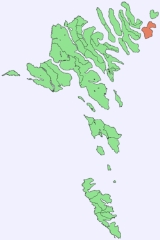
Svínoy
Encyclopedia
Svínoy is an island located in the north-east of the Faroe Islands
, to the east of Borðoy
and Viðoy
. It is divided into two unequally sized peninsulas. The island takes its name from Old Norse, Svíney, meaning "Swine Isle". Svinoy also refers to a section of the ocean where North Atlantic water fluxes into the Norwegian Sea
.
There is a similarly named island, Swona
, in the Orkney Islands.
The island has only one settlement, Svínoy
, where all of the island's inhabitants live. The coast is mostly steep slopes and cliffs, including the 345 m precipice of Eysturhøvdi on the north coast.
He refused to renounce his Catholic
faith and convert to Lutheranism
.
Faroe Islands
The Faroe Islands are an island group situated between the Norwegian Sea and the North Atlantic Ocean, approximately halfway between Scotland and Iceland. The Faroe Islands are a self-governing territory within the Kingdom of Denmark, along with Denmark proper and Greenland...
, to the east of Borðoy
Borðoy
Borðoy is an island in the north-east of the Faroe Islands. There are eight settlements: Klaksvík , Norðoyri, Ánir, Árnafjørður, Strond, Norðtoftir, Depil and Norðdepil. There are also three abandoned settlements: Skálatoftir, Múli and Fossá, all in the north...
and Viðoy
Viðoy
Viðoy is the northern-most island in the Faroe Islands, located east of Borðoy to which it is linked via a causeway. The name means wood island, despite the fact that no trees grow on the island: the name relates to the driftwood that floats in from Siberia and North America.- Geography :The...
. It is divided into two unequally sized peninsulas. The island takes its name from Old Norse, Svíney, meaning "Swine Isle". Svinoy also refers to a section of the ocean where North Atlantic water fluxes into the Norwegian Sea
Norwegian Sea
The Norwegian Sea is a marginal sea in the North Atlantic Ocean, northwest of Norway. It is located between the North Sea and the Greenland Sea and adjoins the North Atlantic Ocean to the west and the Barents Sea to the northeast. In the southwest, it is separated from the Atlantic Ocean by a...
.
There is a similarly named island, Swona
Swona
Swona is an uninhabited island in the Pentland Firth off the north coast of Scotland.-Geography and geology:Swona is the more northerly of two islands in the Pentland Firth between the Orkney Islands and Caithness on the Scottish mainland...
, in the Orkney Islands.
The island has only one settlement, Svínoy
Svínoy, Svínoy
Svínoy is the only village on the Faroese island of the same name in the Svínoyar municipality. The 2002 population was 73. Its postal code is FO 765. Its current church was built in 1878. The name of the island Svínoy means 'pig island'.-External links:*...
, where all of the island's inhabitants live. The coast is mostly steep slopes and cliffs, including the 345 m precipice of Eysturhøvdi on the north coast.
Mountains
There are seven mountains on Svínoy:| # | Name | Height |
|---|---|---|
| 1. | Havnartindur | 586 m |
| 2. | Keldufjall | 463 m |
| 2. | Knúkur, vestari | 463 m |
| 4. | Knúkur Knúkur Knúkur is marginally the highest point of Skuvoy in the central Faroe Islands. Located on the western side of the island, the hill has a height of 392 or 393 metres. Heyggjurin Mikli towards the south of Skandvoy is marginally lower at 391 metres.... |
460 m |
| 5. | Múlin | 443 m |
| 6. | Middagur | 422 m |
| 7. | Eysturhøvdi | 344 m |
History
- 975 Viking Chief Svínoyar-Bjarni is mentioned in the Færeyinga SagaFæreyinga SagaThe Færeyinga Saga , the Norse saga of Faroemen, is the story of how the Faroes were converted to Christianity and became a part of the Kingdom of Norway.-Summary:It was written in Iceland shortly after 1200...
. A headstone in the church is assumed to be Bjarni's memorial stone.
- 1583 Jacob Eudensen from Svinoy is the last person in the Faroe Islands to be condemned to death for heresyHeresyHeresy is a controversial or novel change to a system of beliefs, especially a religion, that conflicts with established dogma. It is distinct from apostasy, which is the formal denunciation of one's religion, principles or cause, and blasphemy, which is irreverence toward religion...
.
He refused to renounce his Catholic
Catholic
The word catholic comes from the Greek phrase , meaning "on the whole," "according to the whole" or "in general", and is a combination of the Greek words meaning "about" and meaning "whole"...
faith and convert to Lutheranism
Lutheranism
Lutheranism is a major branch of Western Christianity that identifies with the theology of Martin Luther, a German reformer. Luther's efforts to reform the theology and practice of the church launched the Protestant Reformation...
.
External links
- personal website with 9 aerial photos of Svínoy

